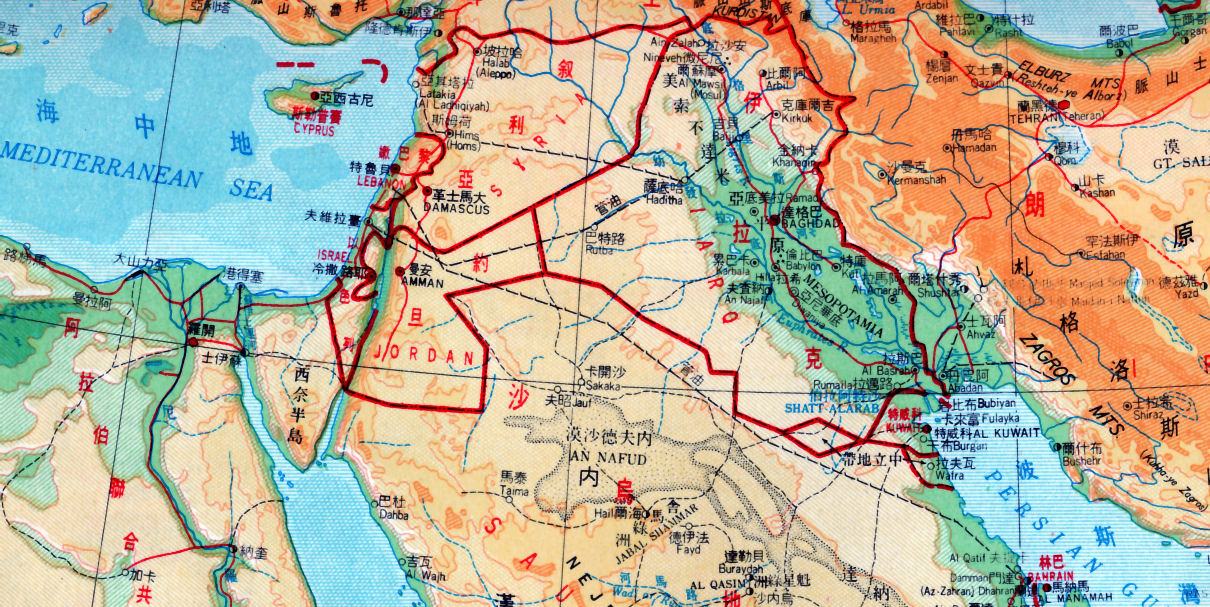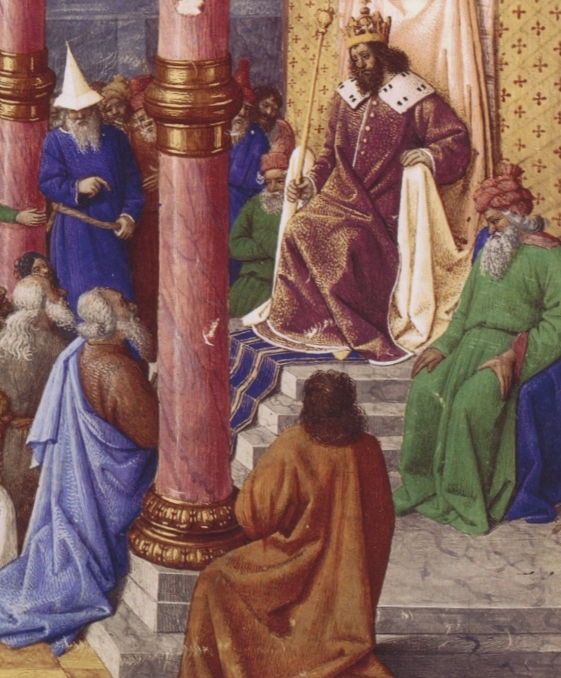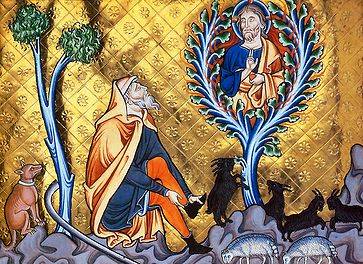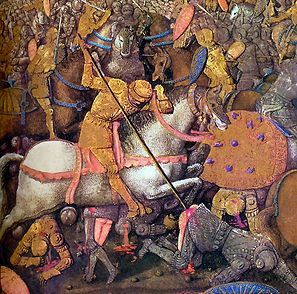
Fertile agricultural lands of Egypt (left), the Levant (center), and Mesopotamia (right). Canaanites were among the nomadic herding peoples in the dry lands of modern Israel and Jordan.
(Map source: 李麗苹 及 黃新南編繪 1974 最新世界分國地圖.台北: 文化圖書公司. P. 13.)
Content created: 2018-08-24
File last modified:
Any college world-civ course in the United States will have a section on the Hebrews, not because of their large numbers or political importance in the ancient world but because of their enormous influence in later history, for it is from this cultural system that modern Islam and Christianity as well as Judaism derive. For present purposes, this page provides a brief timeline and orienting notes. Other pages on this web site include selections from ancient Hebrew writings intended to fill in the picture and provide insight into the perspectives and values of this ancient people. (Link)
The Canaanites lived in the southeastern "Levant." The Levant, a rather vague term, refers to the wide area from the eastern coast of the Mediterranean Sea extending inland approximately to the western boundary of Mesopotamia. Today it encompasses Syria, Israel, the West Bank and Gaza Strip, Cyprus, and Jordan. In most usage, the Levant does not normally extend into Iraq, Arabia, or Turkey.
The name "Canaan" refers especially to the southern part of this area. All Canaanites apparently spoke closely related Semitic languages. The ancient Hebrews were Canaanites, or would be except that the term is often used to refer to their neighbors in contrast to the Hebrews.
Far to the east of the Levant lay the roughly parallel Tigris and Euphrates rivers. The lands along and between these two rivers was Mesopotamia, an agriculturally rich zone that became the seat of various expansionist empires. The arc formed by the Tigris-Euphrates, southern Turkey, and the coastal Levant is usually referred to as the "fertile crescent," (colored green on this map —like Egypt) in contrast to the adjacent lands (yellow on this map), which were very much drier and not suitable for agriculture.
Living in the Levant in theory put at least some of the Canaanites on the Mediterranean coast. But the Canaanites were derived from pastoral nomads moving into the region from the south and east. So their adaptation was not focused on marine resources. Fishing involved rivers and a few lakes or oases, not the sea.
The Hebrews (= Israelites = Jews) were one of many similar, "Canaanite" groups, originally probably transhumant desert herding peoples in most cases, that settled in the southeastern Levant at the end of the Bronze Age or beginning of the Iron Age.

For our story the major Mesopotamian urban centers were Babylon, located in the middle of modern Iraq, roughly where Baghdad is, and Nineveh, roughly at the location of Mosul, in northernmost Iraq, an area known in antiquity as Assyria. Each of these cities was at one time or another the seat of an empire which extended to the Levant, including Canaan. (Click for extended discussions of the bronze and iron ages, Mesopotamia, and Babylonians on this web site.)
Nobody likes dates very well (except weird people), but the order in which things happen can make a difference. So here is a list of dates making up a kind of skeletal history of the Hebrews. READ THIS LIST and enjoy it but there is no reason to memorize it. (In this table BC dates have a minus sign, AD dates have a plus sign.)
| Very Long Ago | God creates the world from primordial chaos. Once everything else is in place, he creates people, who live in the Garden of Eden until, disobeying God's order not to eat the fruit of the tree of knowledge, they are cast out of the Garden. Living in a state of pious regret, they produce children from whom all modern populations are descended. Unfortunately, not all of the children are virtuous. |
| Not Quite So Long Ago | Disgusted by human sinfulness, God sends a 40-day flood. Noah and his family, being exceptions to the general iniquity, are forewarned and build a great boat, an "ark," by which they and a breeding stock of the world's animals are preserved. When the flood recedes and the ark is grounded, God sends a rainbow as a sign that he won't send another flood like this. We can think of this as the first "Contract with God." |
| -1800/1700 | Life of Abraham (who is born in Ur, moves to Harran 600 miles away, then to Canaan, which God tells him he gets to keep so long as Hebrew men are circumcized, the second "Contract with God") (Scriptural account) |
| -1792 to -1750 | Reign of the famous lawgiver Hammurabi of Old Babylon (More on Hammurabi) |
| -1300 | Approximate time of Moses and the third "Contract with God" (Scriptural account) |
| -1200 | A glorious date to memorize (Click me.)
The secret of ironworking leaks out at the collapse of the Hittite empire and warfare gets way more lethal among iron-working states and their allies (like the Philistines) |
| 1000 | Hebrew conquest of the Philistines finally brings them the secret of ironworking so they can be lethal too.
With iron weaponry, King David wipes out the Philistines and other Canaanites and establishes a capital at Jerusalem with walls, and garden terraces just outside them. (Silly aside.) |
| -950 | King Solomon, David's successor, builds his famous temple in Jerusalem roughly on the site of today's Dome-of-the-Rock. |
| -930± | The unified Hebrew state splits into Israel (north) and Judah (south), which don't seem to like each other very well. |
| -924 | Pharaoh Shoshenq I, founder of Egypt's 22nd dynasty, invades Canaan, annoying the Hebrews. (Details) |
| -722 | Assyrians conquer Israel (the northern of the two Hebrew kingdoms) and exile Hebrew elders to Nineveh, the Assyrian capital, providing the background for the stories of Jonah and Tobit (link). |
| -634 to -562 | Babylonian leader Nabopolassar destroys Assyrian power over Babylonia and begins his own empire uniting Babylonians and Medians to their east. Thereafter, Nebuchadnezzar punishes Babylonian client states for failing to help suppress a Median rebellion, forming the background to the story of Judith (link). With Nebuchadnezzar's régime now unchallenged, a tentative piece prevails, the setting for the tale of Daniel at his court in Babylon, where Susanna's husband Joachim is an obviously wealthy leader of an established Jewish community (link). |
| -597 | Judah (the southern of the two Hebrew kingdoms) rebels against Babylon, annoying the Babylonians. |
| -586 | Judah rebels again, annoying the Babylonians even more; the Babylonians destroy Solomon's temple and take some Hebrews to Babylon (and disperse others around their empire). (This is known in Jewish history as the "Babylonian Captivity.") |
| -539 | Cyrus of Persia conquers Babylon and the Babylonians, ending the "Babylonian Captivity" (but some Hebrews have already put down roots in Babylon and elsewhere, so they do not all return to Judah). |
| -516/515 | The Second Temple is constructed in Jerusalem on the site of the first one using funds provided by Cyrus' successor, Xerxes. |
| -400 | The book of Jonah (link) is probably written down, based on popular legends about events in the -700s. |
| -322 | Alexander the Great conquers Jerusalem, which becomes part of the "Seleucid" realm after Alexander's successors divide up his conquests and Seleucus gets this part. The Book of Daniel with its story of Susanna (link) is probably written about this time, based on legends about the life of the prophet Daniel, purported to live in the 500s. (A nativist "Hashmonean" dynasty rules from -140 to -116.) |
| -100 | The books of Tobit and Judith are written down based on popular legends about events in the -600s and -700s. (link) |
| -63 | General Pompey conquers Jerusalem for the Romans. A huge military fort is built looking down into the Temple courtyards, annoying the Hebrews. |
| +66/67 to +70 | In Jerusalem the "Jewish War" involves rebellion by Hebrew Zealots against Rome. The emperor is not amused. |
| +70 | The Romans, under Vespasian, destroy Jerusalem and its temple and prohibit Jews from living on the site. (The prohibition continued under all succeeding governments until it was lifted nearly eighteen hundred years later under the "Edict of Toleration" issued by the Ottoman caliphate in 1844, modeled on a similar Austrian edict in 1782.) |
 Cyrus of Persia was portrayed throughought later Western history as a just ruler because he allowed the Jews to return to Jerusalem and even provided funds to restore the temple. This 1470± painting of Jewish elders before Cyrus was an illustration by the anonymous "Master of the Boccaccio Illustrations" for a 1470 edition of Antiquities of the Jews by Josephus Flavius (AD 37-100).
Cyrus of Persia was portrayed throughought later Western history as a just ruler because he allowed the Jews to return to Jerusalem and even provided funds to restore the temple. This 1470± painting of Jewish elders before Cyrus was an illustration by the anonymous "Master of the Boccaccio Illustrations" for a 1470 edition of Antiquities of the Jews by Josephus Flavius (AD 37-100). Good Buys & Bad Guys. Historians generally find it easier to like Persians than Babylonians and Assyrians. While it is true that Persians are pretty nice folk, the differing approaches to managing conquered Canaan are surely a big part of historians having this feeling.
Ethnicity & Religion. Although they are closely entwined, it is useful to distinguish between (1) Jewish "national" identity, associated with terms like the "tribes of Israel" and seen as being established in a descent line beginning with Abram/Abraham, his son son Isaac, and Isaac's son Jacob, and (2) Judaism as a religion, which is often conceived of as beginning with Moses.
Sources. Almost our exclusive written source for Hebrew history is the Hebrew Bible, broadly corresponding with the Christian Old Testament. Jews refer to the first five books of the Bible as the Torah תּוֹרָה or "Instruction," and consider it by far the most important portion of the scripture. The five books of the Torah are named in English Genesis, Exodus, Leviticus, Numbers, and Deuteronomy, collectively referred to as "the Pentateuch"(PEN-tah-tuke, from Greek pentateuchos πεντάτευχος, "five scrolls").
In general, where archaeology is relevant to the Bible, it usually does NOT disconfirm it, although it rarely gives as clear confirmation as historians would appreciate.
Whatever its possible inaccuracies and incorporation of some clearly mythic material, the Hebrew account of history has had enormous influence on later peoples, and educated people around the world are expected (by other educated people around the world) to be familiar with the outlines of the story.
So-called "charter myths" are a special case of myths in general. They are stories, historically real or not, that provide an account of the origin of an important custom or institution. (Click me.) The foundation stories of Judaism provide excellent examples, since they provide a "reason" for later Jewish practices. A feature that is distinctively Hebraic about them, however, is the theme of the Hebrews as a specific, bounded group of people having a "contract" with God whereby God will safeguard their welfare and protect them from competing groups so long as they behave in accordance with his instructions. This is the feature that is emphasized in the materials selected here.
By way of illustrating the general nature of the texts, this web site includes three stories about covenants with God, Noah and the Flood (extract 1), the story of Abraham (extracts 1-4), and the Moses (extracts 5-6). (Links)

In the selections here, Abraham struggles to produce an heir, but eventually fathers Isaac even though his wife Sarah is 90 years old. Isaac, the son of Abraham and Sarah, in turn fathers twelve sons. Hebrew tradition recounts that the sons of Isaac move to Egypt, where they thrive for a time, presumably under the late XVIIth dynasty Hyksos régime. With the fall of the Hyksos and the establishment of the New Kingdom and the XVIIIth dynasty, the Hebrews in Egypt fall on hard times and become slaves.
In the story, Moses has the misfortune to be born when there has been a prophecy of a great leader about to appear who will liberate the Hebrews, so his mother takes extraordinary measures to conceal him from those who would kill possible new-born liberators. (He is set afloat on the Nile in a way strikingly reminiscent of the story of Sargon being set afloaton the Euphrates a thousand years earlier. See Haywood, p. 28.)
His identity unknown, Moses is eventually raised at court (which he seems to like just fine), falls afoul of the law, and ends up as a shepherd among desert tribes (which he also seems to like just fine).
But God, speaking from the famous Burning Bush (shown here from a French illustration made in 1210), tells him to go back and save the Hebrews. (Link)
As the story continues, Moses leads the Hebrews out of Egypt, with Egyptian armies in hot pursuit. God parts the Red Sea for the Hebrews to cross from Egypt to Sinai, but closes it again as soon as they have safely reached the far shore, drowning the pursuing Egyptian armies. At this point the Hebrews have launched themselves back into the nomadic existence they used to lead before they moved to Egypt. And they head, slowly, to do battle for the "promised land" of Canaan. (You have surely heard this tale, so we don't need the details here.)
Within these texts we see the "charter myths" for a "covenant" or "contract" between God and the Hebrews, the Hebrews being a kinship-based "nation" with God as their special patron. (He is not the only god out there —other peoples have their own gods, at least initially.) (The term "myth" carries unfortunate loadings for some people. Click here for More About Myths.)

From the time of Abraham on, God demands that the contract be entered into fully, and be symbolized by the irreversible genital mutilation of Hebrew men (circumcision) to show that they are part of the contract. (The custom of circumcision continues to be important to Jews to this day, although lots of non-Jews practice it for other reasons. Once common in Europe and North American for "hygienic reasons," it has met increasing opposition in recent years.)
God will later require lots of other signs of loyalty too, including a good deal of animal sacrifice and some of the customs associated today with kosher food. (Click here for a depressing insight.) Much of the Torah's book of Leviticus is devoted to such obligations and taboos. A small portion was included as Extract 7. (Link)
The notion of a covenanted people (the "chosen people") with a special relation to God provides a logic by which to expect that God will intervene on the Hebrew side against their remarkably numerous enemies both as they defend themselves against would-be conquerors, and as they seize the land as conquerors of others. (The picture here, from about 1415, shows King David, in gold armor, killing the Jebusite king in a particularly gruesome and disgusting way in order to take over the Jebusite citadel of Jerusalem and convert it into the "City of David.")
The ancient Hebrews had a the tradition of prophets, i.e., people who deliver stirring spoken messages of great moral clarity or under divine inspiration. Given the notion of the Hebrews having a special covenant with God, it is not surprising that the Hebrew prophets kept either foreseeing doom because the people around them were failing in their piety or calling for doom for the same reason. But they also vividly described what they hoped God would do to their enemies, presumably increasing the martial enthusiasm of Hebrew troops.
The assigned extracts 8 and 9 were more or less random examples (link).
(Notice, by the way, that in our own era, these texts also provide the "charter myth" for the Israeli claim both to the territory of modern Israel and to some lands which lie beyond the borders of Israel as internationally recognized. The position is that the land was granted by God to the Hebrews and to no one else. It was part of the covenant.)
The Hebrews were quite minor players in the tumultuous flux of the early Iron Age in the Near East. Their importance for our own era has been amplified by the preservation of some of their texts, some of which have become sacred in later religious tradition, motivating their careful preservation and intensive study.
Through these texts we see a political order, apparently widespread across the region. It is based on male descent lines, in typically pastoral fashion (link), and on patrimonialism (definition). It is also connected to a religion anchored in a "contract" between such a group and one of the many Near Eastern gods.
(The story of Judith, for example, portrays her as absolutely committed to the idea of such a contract, and completely convinced that of course God will live up to his end of the deal. The story of Tobit plays to the same theme, with God sending his angel to oversee the safety of Tobit's family because the family has been punctiliously true to the contract.)
It is not clear how idiosyncratic the idea of a "contract" is. Patron gods of various other pastoral groups, or of Mesopotamian city states, may well have been imagined in a similar way, although it is probable that the Hebrews were especially single-minded about it.
Being charter myths, but also unchangingly frozen as sacred text, the stories carry the seeds of what are to become future intellectual perspectives, at least according to some analysts. For example:
Return to top.
Go to notes for previous
or next
session.
Background Design: Letters of the Hebrew Alphabet